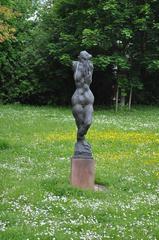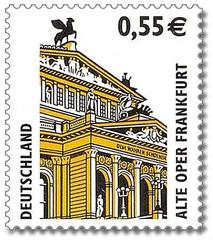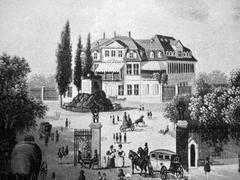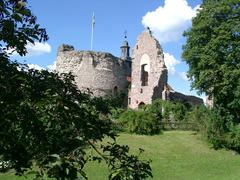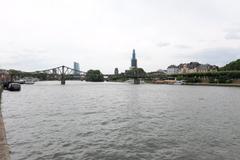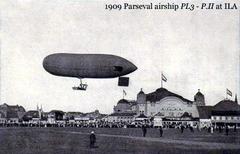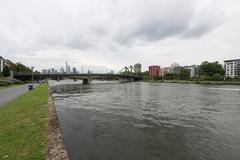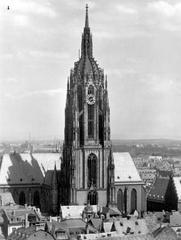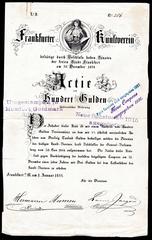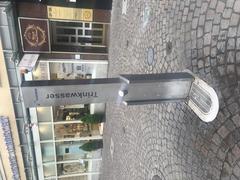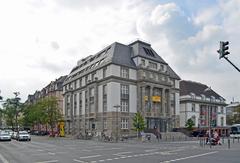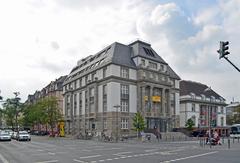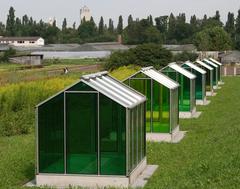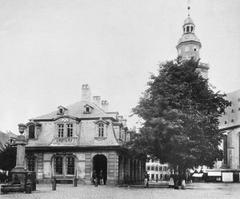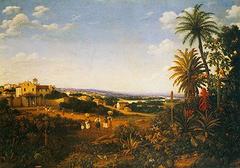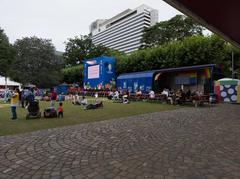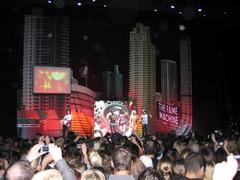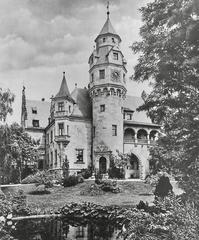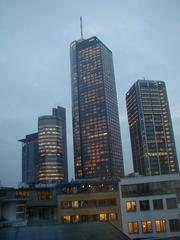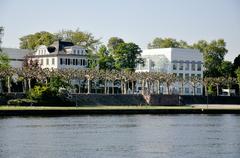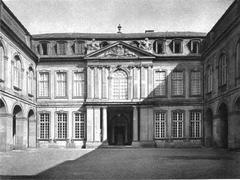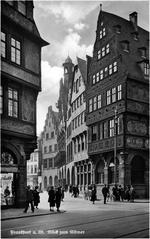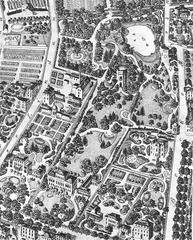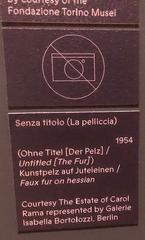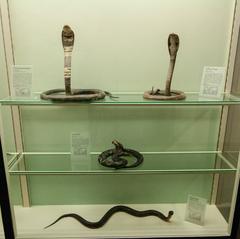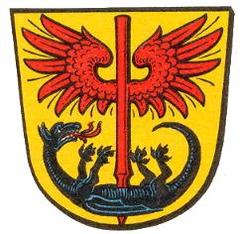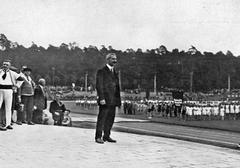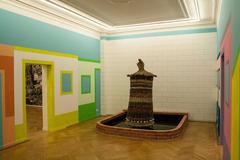Bockenheimer Warte Frankfurt: Visiting Hours, Tickets, and Historical Sites Guide
Date: 04/07/2025
Introduction: Discovering Bockenheimer Warte
Located in Frankfurt’s Bockenheim district, the Bockenheimer Warte is a striking symbol of the city’s ability to blend deep-rooted history with vibrant modern life. Originally built between 1434 and 1435 as part of the city’s medieval defenses, this Gothic watchtower was a sentinel safeguarding Frankfurt’s western approaches along crucial trade routes (Wikipedia). Today, the tower stands at the heart of a bustling square, sharing the stage with the whimsical subway entrance designed to resemble a tram car breaking through the pavement (Atlas Obscura). The area around Bockenheimer Warte is a lively nexus of culture, academia, and community life—making it a must-visit for anyone seeking to experience Frankfurt’s past and present.
This comprehensive guide covers everything you need to know about Bockenheimer Warte, including its historical significance, practical information for visitors, nearby attractions, and tips for making the most of your visit.
Contents
- Historical Background
- Construction and Medieval Role
- Transformation and Preservation
- Visiting the Bockenheimer Warte
- Visiting Hours and Admission
- Directions and Accessibility
- Nearby Attractions and Things to Do
- Experiencing Contemporary Bockenheimer Warte
- Cultural Significance and Community Life
- FAQs
- Visiting Tips and Useful Resources
Historical Background
Construction and Medieval Role
The Bockenheimer Warte (also known as “Wartturm”) was constructed in 1434–1435 as an integral part of the Frankfurter Landwehr, a network of fortifications designed to protect the Free City of Frankfurt during the late Middle Ages (Wikipedia). This cylindrical Gothic tower, topped by a distinctive pyramid-shaped roof, was strategically positioned to guard vital trade routes leading westward toward Cologne via Bockenheimer Landstraße and Leipziger Straße.
The tower’s robust architecture enabled it to withstand potential attacks and provided a vantage point for monitoring travelers and collecting tolls. For centuries, it marked the border between Frankfurt and neighboring Bockenheim—then a separate entity under the Electorate of Hesse (Wikipedia). Originally, the tower was accompanied by a fortified courtyard and ditches, but today only the tower remains, standing as a rare and well-preserved example of Frankfurt’s medieval defensive architecture (Evendo).
Transformation and Preservation
As Frankfurt expanded in the 19th century, the defensive role of the Bockenheimer Warte faded. The surrounding fortifications disappeared, and Bockenheim was incorporated into the city. Despite wars and urban development, the tower endured, surviving the upheavals of the Napoleonic era and World War II (Evendo).
Ongoing conservation efforts have preserved the tower’s Gothic silhouette. Today, it is protected under the Hessian Monument Protection Act, recognized as a cultural monument (Wikipedia). Although the interior is not open to the public, the exterior can be admired from the lively square that surrounds it.
Visiting the Bockenheimer Warte
Visiting Hours and Admission
- Tower Exterior: Open 24/7; visitors can view and photograph the exterior at any time.
- Tower Interior: Not open to the public.
- Admission: No ticket or entrance fee required to visit the tower or the surrounding square.
Directions and Accessibility
- Public Transport: The Bockenheimer Warte U-Bahn station is a major hub, served by lines U4, U6, and U7, plus tram line 16 and several bus routes (Evendo).
- By Car: Several parking garages are nearby, though spaces may be limited during peak periods.
- Cycling & Walking: The area is bike-friendly and walkable, with dedicated lanes and wide sidewalks.
- Accessibility: The square and station feature ramps and elevators for wheelchair users and those with mobility challenges.
Nearby Attractions and Things to Do
- Goethe University: The main campus, with its modern architecture and green spaces, is just steps away.
- Senckenberg Natural History Museum: Famous for its dinosaur skeletons and family-friendly exhibits (Senckenberg Museum).
- Palmengarten: Frankfurt’s renowned botanical garden is a 10-minute walk from the square (Palmengarten).
- Leipziger Straße: A lively shopping and dining street, home to independent boutiques, cafés, and restaurants (The Frankfurt Edit).
- Bockenheimer Depot: A former tram depot now hosting theater and cultural events.
Experiencing Contemporary Bockenheimer Warte
The Iconic U-Bahn Entrance
A highlight for many visitors is the playful U-Bahn station entrance, designed by Zbigniew Peter Pininski in 1986. Shaped like a subway car erupting from the ground, it is both a functional transit point and a celebrated piece of public art (Atlas Obscura). The entrance has become an iconic photo spot and a symbol of Frankfurt’s creative urban spirit.
Vibrant Square Life
The square around Bockenheimer Warte is a hub of community activity. Weekly markets (especially on Thursdays), open-air events, and cultural festivals bring together locals, students, and visitors. Cafés, kiosks, and international eateries line the square and adjacent streets, making it a perfect spot to pause and soak up Bockenheim’s diverse atmosphere.
Cultural Significance and Community Life
Bockenheimer Warte embodies Frankfurt’s resilience and its tradition of blending innovation with heritage. The tower is a tangible reminder of the city’s medieval past, while the subway entrance and nearby Brutalist and modernist structures highlight ongoing architectural evolution (Archgyan).
The area’s proximity to Goethe University and its legacy as a student district contribute to a lively, cosmopolitan scene, with street art, galleries, and community events reflecting Bockenheim’s creative energy.
Frequently Asked Questions (FAQ)
Is the Bockenheimer Warte tower open inside?
No, the interior is not accessible, but the exterior can be viewed at any time.
What are the visiting hours?
The tower’s exterior and the square are open 24/7.
Do I need a ticket?
No, visiting the tower and square is free.
How do I get there by public transport?
Take U-Bahn lines U4, U6, or U7 to Bockenheimer Warte. Tram line 16 and several bus routes stop nearby.
Are guided tours available?
Yes, several local walking tours include Bockenheimer Warte among their highlights.
What else is nearby?
Senckenberg Natural History Museum, Palmengarten, Goethe University, and Leipziger Straße are all within walking distance.
Is the area accessible?
Yes, the square and station are wheelchair-friendly, with ramps and elevators.
Visiting Tips and Useful Resources
- Best Time to Visit: Spring and early autumn are ideal for mild weather and fewer crowds. Summer is lively, while winter brings festive markets (Destination Abroad).
- Transport: Purchase day passes or group tickets for cost-effective city travel (Travel Tom Tom).
- Safety: The area is safe and welcoming, especially with its student population and cultural vibrancy.
- Events: Check local listings and The Frankfurt Edit for up-to-date information on street festivals and community happenings.
- Sustainability: Use public transport, bring reusable water bottles, and respect local recycling and green initiatives (Frankfurt Tourism).
Related Articles and Further Reading
- Bockenheimer Warte (Wartturm), Wikipedia
- Bockenheimer Warte (Wartturm), Evendo
- Bockenheimer Warte Subway Station Entrance, Atlas Obscura
- Bockenheim District and Local Insights, The Frankfurt Edit
- Visiting Frankfurt Guide, Travel Tom Tom
- Senckenberg Natural History Museum Frankfurt
- Palmengarten Botanical Garden
- Frankfurt Tourism Official
Plan Your Visit
Experience Frankfurt’s dynamic blend of history, culture, and innovation at Bockenheimer Warte. Download the Audiala app for maps, guides, and insider tips, and follow local cultural organizations for news on events and exhibitions. Whether you’re tracing medieval walls or snapping photos at the famous subway entrance, your visit to Bockenheimer Warte will offer an authentic glimpse into the spirit of Frankfurt.
